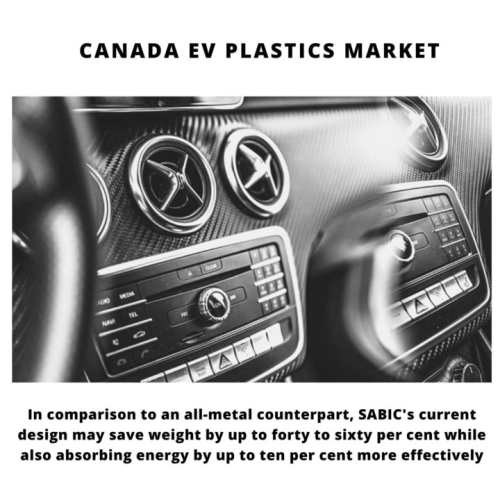
- Get in Touch with Us

Last Updated: Apr 26, 2025 | Study Period: 2024-2030
Despite the fact that metal is still the material of choice for making many auto parts, the resultant increase in vehicle weight has compelled automakers to look for alternatives in order to maximize overall vehicle efficiency. Thus, after metal, plastics are the material utilized most frequently today to manufacture various automotive elements.
The increased need for high-performance plastic to ensure passenger security and safety is the main factor driving the market. The sector is also growing as a result of the increased interest in lightweight electric cars.

Particularly in the aftermath of the COVID-19 outbreak, micro mobility is growing in popularity, creating profitable opportunities for market development.
The industry is also predicted to gain from increased consumer and government investment in EVs, as well as from tighter environmental regulations intended to encourage electrification.
The Canada EV Plastics Market accounted for $XX Billion in 2023 and is anticipated to reach $XX Billion by 2029, registering a CAGR of XX% from 2024 to 2030.
Insights on material solutions to promote the development of electric, connected, and autonomous cars are being shared by SABIC, a worldwide leader in the chemical industry and the top supplier of thermoplastics to the automotive sector.
This is particularly true as manufacturers switch to bigger batteries that must be mounted to the floor panel of the car. The traditional countermeasure used nowadays to stiffen the rocker panel for battery protection is multi-piece stamping reinforcements.
These metal options, however, increase the weight of the vehicle, which may have an impact on both efficiency and range.
SABIC has designed a structural hybrid solution employing both plastic and metal to provide a lighter reinforcement element and one that can actually increase crash performance.
This solution draws on SABIC's expertise in crash and chassis solutions. In comparison to an all-metal counterpart, SABIC's current design may save weight by up to forty to sixty per cent while also absorbing energy by up to ten per cent more effectively.
This reinforcement extends the spectrum of thermoplastic hybrid products created by SABIC, which have the ability to reduce the weight of a vehicle's body-in-white by up to twenty kilograms.
| Sl no | Topic |
| 1 | Market Segmentation |
| 2 | Scope of the report |
| 3 | Abbreviations |
| 4 | Research Methodology |
| 5 | Executive Summary |
| 6 | Introduction |
| 7 | Insights from Industry stakeholders |
| 8 | Cost breakdown of Product by sub-components and average profit margin |
| 9 | Disruptive innovation in the Industry |
| 10 | Technology trends in the Industry |
| 11 | Consumer trends in the industry |
| 12 | Recent Production Milestones |
| 13 | Component Manufacturing in US, EU and China |
| 14 | COVID-19 impact on overall market |
| 15 | COVID-19 impact on Production of components |
| 16 | COVID-19 impact on Point of sale |
| 17 | Market Segmentation, Dynamics and Forecast by Geography, 2024-2030 |
| 18 | Market Segmentation, Dynamics and Forecast by Product Type, 2024-2030 |
| 19 | Market Segmentation, Dynamics and Forecast by Application, 2024-2030 |
| 20 | Market Segmentation, Dynamics and Forecast by End use, 2024-2030 |
| 21 | Product installation rate by OEM, 2023 |
| 22 | Incline/Decline in Average B-2-B selling price in past 5 years |
| 23 | Competition from substitute products |
| 24 | Gross margin and average profitability of suppliers |
| 25 | New product development in past 12 months |
| 26 | M&A in past 12 months |
| 27 | Growth strategy of leading players |
| 28 | Market share of vendors, 2023 |
| 29 | Company Profiles |
| 30 | Unmet needs and opportunity for new suppliers |
| 31 | Conclusion |
| 32 | Appendix |